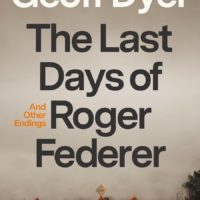What’s your book about? Much of popular literary discourse begins and ends with that question. Moby-Dick is about a whale hunt, and War and Peace is about Napoleon’s invasion of Russia. These descriptions might not be inaccurate, but they reveal little about the nature and scope of these novels, and they make us forget a basic truth about literature: that the literary sometimes involves central conceits being pushed to the margins and the marginal given center stage. The whale is as elusive as God in Melville’s masterpiece, and Napoleon is a forgettable supporting character in Tolstoy’s great novel.
Maybe it would help if we rephrased the inquiry a little, by changing the operative preposition from “about” to “around.” I think I came across this idea in a Julian Barnes interview. He was talking about his novel The Noise of Time, and said something to the effect that his novel wasn’t so much about the Russian composer Dmitri Shostakovich as written around him. I haven’t read the novel, and I don’t know what Barnes really had in mind when he said this (or if indeed he actually said this). But I am excited by this idea of the writer snubbing his subject, distracted by other things. To my understanding, this isn’t merely a matter of a semantic shift—about/around—but a bigger creative reconfiguration: It’s a rejection of that old notion that art has to be wedded in some way to the principal subject or theme. To write around a subject grants you the freedom to disengage and look away, and the freedom to take your divagations seriously.
This kind of imaginative infidelity is always in evidence in Geoff Dyer’s work. Some of his best books have been written around one big subject—jazz, photography, D.H. Lawrence, Tarkovsky’s Stalker. If we were to graph the “narrative arc” of these books, it would be riddled with tangents. You lose your bearings when reading Dyer and realize soon enough that the subject is merely a backdrop against which the real action, the writer’s imagination, unfolds. The principal subject is like a familiar reference point, sometimes distant, sometimes up close, reminding us why we started reading the book in the first place. But the ideal way to read Dyer is to forget what the book is about and why we started reading it, and submit to the writer’s whims.
At one point, this about/around dichotomy is directly addressed in Dyer’s The Last Days of Roger Federer, when his attention zooms out, as it were, from the assemblage of topics at hand, the major and minor subjects the author is immersed in, to take in the big picture: the book itself, which, the author says, is “about a congeries of experiences, things, and cultural artefacts that, for various reasons, have come to group themselves around me in a rough constellation during a phase of my life.”
Books of this category—that is, books that are difficult to categorize—have to be defined and redefined as they are being written and as they are being read. The reader and writer are both required to think, again and again, about what kind of book it is, and what kind of book it isn’t. The Last Days is a meditation on aging as well as a Cheeveresque record of personal foibles and failures; it is a work of art appreciation and criticism, written from the point of view of an enthusiast rather than that of a critic; it is also a book centered on reading and writing, and on not being able to read and write for various reasons.
The Last Days, however, is not the kind of book that must be true to its title. It has nothing much to do with tennis or with Roger Federer, who appears sparingly in these pages—mostly as part of Dyer’s memories of watching tennis—and hovers above the narrative as a symbolic presence, representing life force and eternal youth, but at the same time making us think of the inevitability of decline and of that ageless tussle between talent and time.
It’s also not the kind of book that must be true to its subtitle, “And Other Endings.” Dyer tells us that his book is not “intended to be a comprehensive study of last things, or of lastness generally.” It’s also not, in Dyer’s words, an “injury diary” of a sixty-plus man, though the author keeps us apprised of his orthopedic troubles—”rotator cuff, hip flexor, wrist, cricked neck, lower back, and bad knees (both)”—and brings to vivid life what Larkin in his poem ‘The Old Fools’ called “the constant wear and tear / of taken breath.”
Youth has great value in the arena of sports, where every failure, every setback is a simulacrum of old age. When Dyer writes about watching tennis stars like Federer and Andy Murray giving their best on the court, he does so with both admiration and envy. And these emotions give way to self-pity when Dyer starts recounting his own bungled, not to mention self-destructive (see above), attempts at playing tennis.
Dyer has long been preoccupied by the figure of the vulnerable athlete. In a brilliant essay entitled “Ecce Homo,” from his 1999 collection Anglo-English Attitudes, he compares, through a set of photographs and paintings, the figure of the fallen athlete to that ultimate embodiment of virtue and weakness in Western mythology: Jesus Christ. In the tired eyes of the boxer Barry McGuigan, Dyer sees “the unfocused agony of the Passion.” It could be this passion that he is searching for in the lives of the great sportsmen who have reached, or will soon reach, the end of the road. Federer was on the last legs of his tennis career (yet in supernatural form) when this book was being written. He finally retired in September 2022, and photos from his grand send-off ceremony in London show him and his tennis bête noire Rafael Nadal crying like babies. None of the noble grief of the Passion paintings here, but something more human, reminiscent of the wailing followers of Christ in one of those Lamentation paintings. I wonder what Dyer would make of these photos.
In The Last Days, the focus shifts from subject to subject. The flailing athlete makes way for the croaking singer (late-life Bob Dylan) and the blocked writer (post-celebrity William Burroughs). Dyer is interested in failure not merely as an age-related phenomenon but as an integral part of the creative process. The critic Cyril Connolly warned young writers against the many hindrances that can spell an early end for their literary career in his book Enemies of Promise, which Dyer summarizes as a study of “the multitudinous ways in which writers give up, the many things that help put them to sleep.” And late into The Last Days, he reminds us, as well as himself, that “giving up” is the one theme on which all his work has been centered. “That’s what’s kept me going,” he writes.
Writers who give up writing are part of a fascinating history—from Rimbaud, who quit being a poet one fine day, travelled east and ended up as an arms dealer of sorts, to Philip Roth, who decided to retire from the writing life at the age of seventy-nine, having had enough of the daily grind and the stupefying glare of the blank page. Dyer once said that continuing to write is his way of postponing his retirement. One more day, the writer says to himself, one more sentence, one more book—knowing full well that most of his days are being wasted, that most of his sentences will have to be rewritten, and that most of the books he tries to write will remain unwritten.
Indeed, The Last Days is, among other things, an attempt on the author’s part to breathe life into one of his own unwritten books. Dyer tells us that he once attempted to write a book structured around three principal figures—something like Fleur Jaeggy did with her beautiful These Possible Lives, featuring Thomas De Quincey, John Keats and Marcel Schwob, though Dyer doesn’t mention Jaeggy. Dyer was sure of two of his subjects—the English painter Turner and the German composer Beethoven, both near-contemporaries, equally uncouth socially and manically productive in the late phase of their lives.
Now Dyer needed a third figure to complete the trinity, for no better reason than his hunch that “a trio or triangle would lend stability to a structure that might otherwise be flimsy.” Of course, the excuse itself is flimsy, but it leads Dyer to an area seldom explored by writers, for it is a literary dead end: “books you can’t and won’t write.” George Steiner’s My Unwritten Books is a classic in this genre. And Dyer’s new one is certainly an addition to that diminutive list, notwithstanding his assertion that there’s actually no such thing as an unwritten book. “Those unwritten and unwritable books,” he says, “become part of—get folded into—a book one can write. This one.”
Another unwritten book that Dyer has been trying to write all his life, the one that gets folded into whatever he is able to finish, is the book that deals with the life and ideas of Nietzsche. In Dyer’s writing, Nietzsche is the musical equivalent of the tonic, the note to which the rest of the melody is anchored. Nietzsche isn’t so much an intellectual guiding light for Dyer as an obsession. As Dyer wrote in a 2011 Guardian piece about his “hero”: “I keep reading Nietzsche and I never cease to be astonished by his insight, his freshness, his brevity (deep problems treated like cold baths: in and out as quickly as possible), his profound plumbing of consciousness, even his ‘howlers’ (as Cioran termed them).” Only Dyer could have come up with that cold bath metaphor, and followed it by that apposite gerund “plumbing,” in the context of high philosophy.
In The Last Days, Dyer pretty much covers, in brief, the entire arc of Nietzsche’s troubled life—from his hysterical episodes of writing and rewriting to his mental breakdown, from his bitter row with his mentor Wagner to his alleged anti-Semitism. Dyer is taken with Nietzsche’s quasi-spiritual concept of the Eternal Recurrence, possibly the only secular philosophy that aims to attribute real “meaning” to life. It’s a variation on the Vedic idea of birth and rebirth, the continuing cycle of life and death and life again—except in Nietzsche, your new life will exactly resemble the old, from one moment to the next. It’s a carpe-diem exhortation: make the best of the life that you have, not because this is the only life you will get but because you will have to relive it over and over again.
In Nietzsche’s own case, as Dyer reminds us, this eternal recurrence would entail “long days and nights of his loneliest loneliness, the constant illnesses and headaches, the renewed hopes followed always by fresh disappointments, the gradually increasing sense of having been catastrophically overlooked (and the attendant, swelling sense of megalomania).” And, one could add, the culmination of his life into eternally recurring madness. Nietzsche’s philosophy magnifies the tragedy of his own life. In his engagement with Nietzsche’s ideas, Dyer emphasizes that tragedy, that vulnerability, that wounded pride and weakness, that “courtesy of the heart” that Nietzsche embodied. And in doing so, he dispenses with the insufferable pop-culture image of Nietzsche as the poet of the grandiloquent (“I am dynamite,” etc.).
The Last Days is even structured like a Nietzsche book, written as a series of linked and unlinked fragments, all sequentially numbered. This form gives Dyer the space and excuse he needs to meander, so that he can tell the reader about, among other things, stealing shampoo from hotels (again the bathroom motif), abandoning The Brothers Karamazov after page 80, consulting a “highly priced” Chinese doctor for his hip flexor, and tripping on a hallucinogenic drug called DMT.
This leaves us with the question we started with: What is the central idea or argument or theme this book is set around? The term “lockdown” comes up every once in a while in the narrative, making the reader wonder if this book, like so many others published recently, was shaped in some essential way by the imposed loneliness of the pandemic. But then we remember that anyone who wishes to seriously write has to get used to living at least in a state of partial lockdown throughout their life. (The Nietzschean prospect of eternal recurrence seems particularly dreary in this context.) “Without Covid,” Dyer writes, “the life I would have led in 2020 would have been broadly the same as the one I led in 2019…” So this isn’t a lockdown book. Another negative definition that leaves us none the wiser as to the true range of this strange and wonderful book—at the center of which is a writer’s omnivorous imagination, engaging indiscriminately with what Nietzsche called the phenomenon of life.
***





